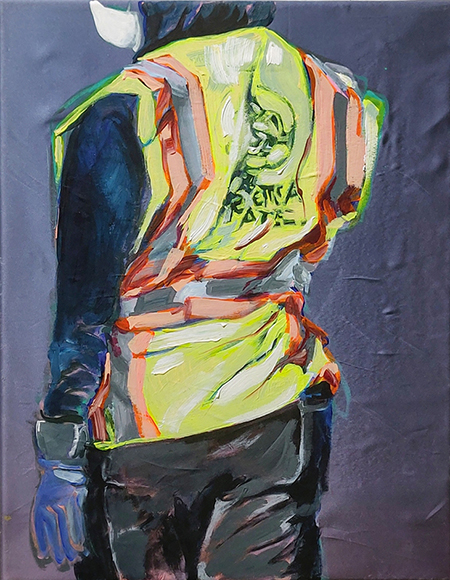
Affixed to stretcher bars, or hanging from rods and pins, the silk substrates of Maggie Crowley’s gouache paintings and constructions set the tone for her solo exhibition, “Playmate.” Crowley’s silk is crushed, folded and creased, exaggerating the way gallery lighting bounces off the surface, asserting the works’ presence and physicality. More so does the silk underscore the narrative content of her works: it reflects light in a way very similar to that of the hi-vis reflective piping that is a staple of safety workwear. In “Playmate,” Crowley highlights the labor that is often judged as being “invisible,” not just by pointing out the essentialness and dignity of the work, but by capturing the nuances of the lives associated with it.
Workwear and PPE feature prominently as Crowley’s subject matter. In works like “Metra Worker on Easter,” “Streets and Sanitation Employee,” and “Receptive, Cooperative, Dependable,” the artist paints portraits of workers, their yellow and orange safety vests rendered so as to draw focus to the motions of their wearers. One vest ripples as a worker lunges to the side, hand outstretched; another creases as a wearer cranes their neck while ascending a ladder; yet another twists around to the side as someone pauses to rest a gloved hand on a hip. As much as these portraits make visible the laborers and the labors they perform, it’s not simply the depictions of what happens on the job site that make “Playmate” so affecting. Amongst Crowley’s portraits, and other imagery of work jackets, trucks and scrubs, are other still-lifes and vignettes that have little-to-nothing to do with the labor, but might have very much to do with the individual performing the labor, and those around them. In particular, imagery like a fishing tackle box, the bouquet in “Anniversary,” and “Paper Snowflake” speak to leisure, occasions and loved ones.
In her artist statement, Crowley explains that she is the daughter of a hairdresser and an ironworker, and perhaps it is exactly that proximity that makes her vantage point so dimensional. “Playmate” is a holistic picture of a life sustained and enriched by the fruits of manual skilled labor. Crowley’s exhibition is humanizing and personalizing, and is on display at an ideal moment amidst the pandemic —right when we all need to be reminded of and refocused on such things.
The blue-collar work that keeps a city functioning is only one example of the labors that have been taken for granted while the rest of the population is safe in quarantine. Joanne Aono’s exhibition, “Harvesting Ethnic Roots,” highlights another: agriculture. Where Crowley focuses on individuals, presenting laborers as visible and whole, Aono mines the histories of communities, shedding light on those who have shaped what we grow and what we consume.
“Harvesting Ethnic Roots” is an installation of large-scale drawings on garden fabric, hung from the ceiling in three rows, encouraging us to walk among the pieces. Aono’s exhibition is on display at boundary — one of a handful of Chicago’s backyard gallery spaces that serve as a crucial site for artistic experimentation, and as an informal and accessible venue in which to see contemporary art. Aono’s research into the ethnic makeup of Morgan Park (the far south side neighborhood where the gallery is located) determined the imagery of her drawings and the order in which they are layered in space. In the back of the room, life-size renderings of strawberries, corn and wild rice represent the foodstuffs of Native American cultures; in the middle are those which were introduced with the European settlers, like cabbage and wheat; in the front are the sweet potatoes, okra and collard greens cultivated by Black Americans. Depending on where a viewer stands, one can see the hanging garden rows separately and distinct from one another, or as a single unit of blended layers.
However, it is the inclusion of another of Aono’s artworks installed outside the gallery that drives the point of her whole exhibition home. The word “HARVEST” is spelled out in seeds of different tones atop a low platform. As the neighborhood birds and critters help themselves to the seeds, a quote from activist Fannie Lou Hamer is revealed on the platform’s face: “If you give a hungry man food, he will eat it. If you give him land, he will grow his own food.” With Hamer’s words reverberating in your mind, the medium of Aono’s drawings is especially potent. The garden fabric, or row cover, is almost transparent, so airy and delicate is its weave; the fabric’s intended use is protective, shielding plants from heat, frost and insects. This is a time of multiple crises — the pandemic (and its effect on supply chains), climate change, and cultural upheaval — and in “Harvesting Ethic Roots,” Aono uses these two traits, the delicate and the protective, to illustrate the state and cultural weight of agriculture in America, and how we might regard it.
